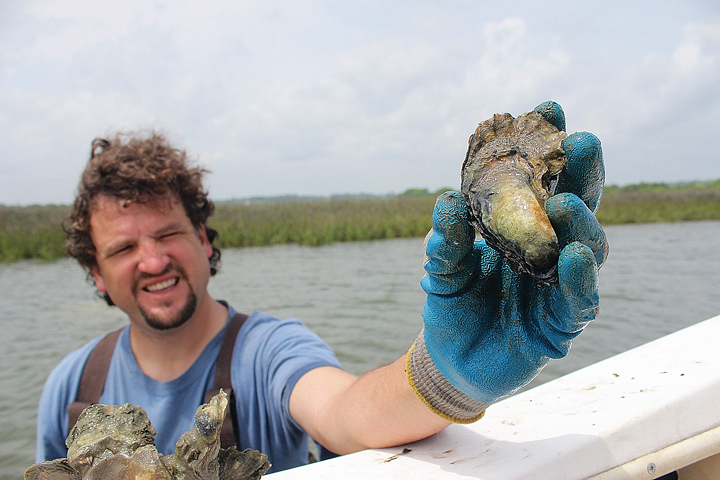By Samantha Santana
The clouds overhead were gray Tuesday, April 29.
“There’s a thunderstorm warning,” said local oysterman Henry “Bubba” Temple.
Temple got his start after growing up with a family who fished recreationally. For Temple, an occupation that involved being in the water was a natural calling.
“I always enjoyed being in the marsh, being in the water,” Temple said.
He lived in Maine working in the commercial scallop industry, and later as a fishing guide in Western North Carolina before moving back to Wilmington.
“I did commercial scallop diving, diving deep sea scallops and harvesting,” Temple said. “The water temperature is a lot colder. You’re dealing with 36-degree water temperature and 5 [below zero] air temperature. We had to wear dry suits, but it’s still cold.”
When oyster season began in October 2011, Temple moved back to Wilmington and started work as an oysterman.
“It’s something I knew how to do,” Temple said. “Small price for a harvester license and if you have a boat, you have a job. I didn’t have to be at the mercy of a boss. I don’t have to wait for them to employ me and ask for raises and be at the mercy of them.”
Oyster season begins Oct. 15 and ends March 31. Temple’s workdays vary day-to-day depending on the tide. Typically, he works for six to nine hours per day, three to four days per week.
“My day depends on the tide charts,” Temple said. “Four hours before low tide, I’m gassing up the boat. I usually head out two hours before low tide. I start picking oysters. I got a sled that floats and bushel baskets that go in the sled. [I] pick up the oysters and throw them in the basket.”
Despite the gray clouds and the chance of thunderstorms, Temple set out toward Masonboro Island.
“My wife and I go out 52 miles from the Frying Pan Tower,” Temple said as the motorboat passed Masonboro Inlet. “We go spend the night; take a bunch of ice and food and make a bed in [the boat]. Get out there in the afternoon, spend the night and fish all day the next day.”
After putting on light brown waders and getting off the boat, Temple walked around to feel for soft sand that sinks when stepped on.
He dumped two full bags of oyster shells.
“It’s really simple,” he said. “The oyster shell recycling program is really important. …You’re giving them a habitat, a structure to live on.”
During the summer, oyster larvae, carried by tides, look for surfaces to attach to. After attachment, the larvae will begin to grow their own shells. The recycled oyster shells not only serve as larvae habitats, but also are kept out of landfills and driveways.
“I love it,” Temple said about the oyster industry. “I purchased a lease last summer and the lease, along with a closed-season permit, allows me to harvest in the summer. It’s fun to be able to plant and harvest my own oyster beds.”
After he is finished harvesting, he uses a tagging system to not only inform buyers of the oysters’ freshness, but as a way to trace the origin of the oysters in the event of an outbreak.
On average, Temple collects three to five bushels per day.
“I try to get five bushels. I wash them off and sell them by the bushel. What people would do is steam them and have a big oyster roast,” Temple said. “We’re lucky. We have really good oysters and we’re overlooked. In my opinion, we have some of the finest eating oysters in the world.”
Temple said the bushel prices are dependent on the demand of oysters, and many of the oystermen can make a comfortable living.
“You don’t make a lot of money. You make a lifestyle,” Temple said.
Temple recycles oyster shells on his lease when the larvae peak during April through July.
“If you get it when the larvae is at its highest peak, you can get over cluttered beds. They’re competing so much; none of them grow to a good size. I like to start planting in April and plant every other week,” he said.
There were large oyster beds protruding from the water’s surface and, as the boat passed by them, Temple said the state’s oyster bed had a positive impact.
“Having a demand for oysters is a good thing. That justifies the price and tax money used to plant beds. One oyster filters 40 gallons of water per day. That’s like a cleaning system. They make the water clean. It’s real important to have [oysters].”
The boat headed toward the dock and on the second floor of his parents’ house, Temple’s mother cradled his infant son as they smiled and waved at him. Temple waved back.
“That’s my mom and my son up there,” Temple said, smiling.




